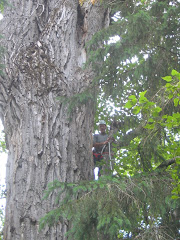This project team is looking for university faculty and student participation. If you are interested, contact jullm@unbc.ca.
__________________________________
When it comes to resource extraction leaving something behind for wildlife is usually considered to be a good, sustainable practice. For example, “leave-trees” are left standing to enhance the biodiversity of a forest after it has been harvested; but what happens to these trees once the harvesting is done and the stand is planted?
Interior Douglas-fir plays a unique ecological role in the sub-boreal forests of Central BC. Relatively rare in these ecosystems, recent government policy requires forest practices that retain individual Douglas fir trees in harvested stands. This has started some debate among forestry professionals. Anecdotal evidence report high mortality and wind damage to the leave-trees spurring questions about the effectiveness of this practice. Will it really accomplish what was intended?
Douglas-fir typically represents a smaller component of pine, spruce and hardwood leading stands in Central Interior ecosystems. More fire-resistant than other species, it can grow to large sizes (as much as 3 metres in diameter) and can get very old (as much as 500+ years) relative to the surrounding tree species. These characteristics make Douglas-fir an important tree for future wildlife habitat: a perching spot for raptors, a home for cavity nesting birds, and a source of food for squirrels.
Mike Jull, manager of the Aleza Lake Research Forest, wants to get to the bottom of the debate. Funded by the BC Forest Science Program, Jull is examining the long-term fate of Douglas-fir left behind in harvested areas and plantations. The project is a partnership of the Aleza Lake Research Forest, the John Prince Research Forest, and the BC Ministry of Forests (Northern Interior Region).
The research sites include areas that were harvested between 1995 and 2007, representing a range of sub-boreal ecosystems. Ultimately, the intent of the project team is to carry out long-term monitoring and build important baseline information for assessing the survival of Douglas-fir leave trees and the habitat values they provide throughout their lifespan.
Will Douglas-fir leave trees provide the long-term biodiversity services that foresters hope to maintain? Only time will tell. But rest assured, some one is keeping an eye on them…
Wednesday, March 26, 2008
If you leave a tree standing, will it survive?
Labels:
Forest Management,
Research



No comments:
Post a Comment